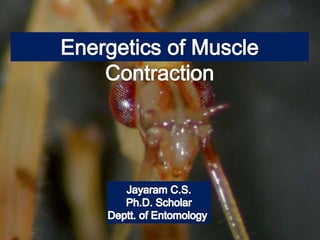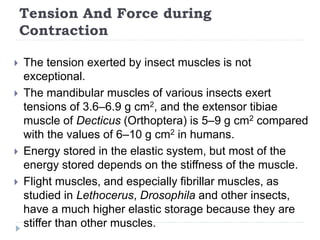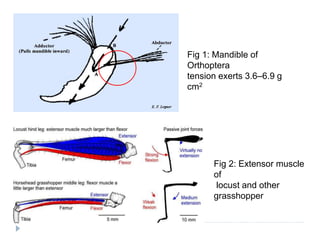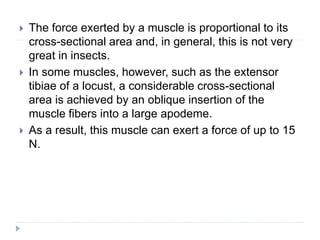Insect Muscular System
The document discusses muscle force, tension, work, energy and power in insects. It defines these terms and provides examples of force measurements in insect mandibular and extensor muscles comparable to human values. Flight muscles store elastic energy due to their stiffness. The force exerted depends on muscle cross-sectional area, with the locust extensor tibiae muscle reaching 15N due to fiber oblique insertion. Twitch duration varies by temperature, fiber type and between antagonistic muscles during flight. Direct power measurements of insect flight muscles show maximum values of 130W/kg and 110W/kg. Oxygen is supplied to flight muscles through a specialized tracheal system with fine tracheoles near mitochondria to support their high metabolic demands.















Recommended


























































More Related Content
Similar to Insect Muscular System (20)






































Recently uploaded (20)






























Insect Muscular System
- 2. Definitions ’üĮ FORCE: Force is an influence causing a mass to change its state of motion, so that it accelerates or decelerates. ’üĮ A muscle generates a force as it contracts because of the resistance of the object being moved ’üĮ The unit of force is a Newton, N= kgms-2. ’üĮ TENSION: Tension is produced by opposing forces pulling on an object. Tension in a muscle normally rises to a peak as the muscle begins to shorten and then falls again as shortening continues.
- 3. ’üĮ WORK: Work is the application of a force over a distance, or a measure of the energy transferred by a force. ’üĮ ENERGY: Energy is the ability to do work. The unit of energy is the same as the unit of work, the joule (J). J= Kgm2s-2 ’üĮ POWER: Power is the rate of doing work, or the rate at which energy is supplied. The unit of power is the watt (W). W = kg m2s-2
- 4. Tension And Force during Contraction ’üĮ The tension exerted by insect muscles is not exceptional. ’üĮ The mandibular muscles of various insects exert tensions of 3.6ŌĆō6.9 g cm2, and the extensor tibiae muscle of Decticus (Orthoptera) is 5ŌĆō9 g cm2 compared with the values of 6ŌĆō10 g cm2 in humans. ’üĮ Energy stored in the elastic system, but most of the energy stored depends on the stiffness of the muscle. ’üĮ Flight muscles, and especially fibrillar muscles, as studied in Lethocerus, Drosophila and other insects, have a much higher elastic storage because they are stiffer than other muscles.
- 5. Fig 1: Mandible of Orthoptera tension exerts 3.6ŌĆō6.9 g cm2 Fig 2: Extensor muscle of locust and other grasshopper
- 6. ’üĮ The force exerted by a muscle is proportional to its cross-sectional area and, in general, this is not very great in insects. ’üĮ In some muscles, however, such as the extensor tibiae of a locust, a considerable cross-sectional area is achieved by an oblique insertion of the muscle fibers into a large apodeme. ’üĮ As a result, this muscle can exert a force of up to 15 N.
- 7. Twitch duration of the muscles ’üĮ The duration of each muscle twitch, the time for it to shorten and relax, is temperature dependent. ’üĮ Efficient flight by Schistocerca requires a wing beat frequency of about 20 Hz, with a period of about 50 ms, only above 30┬░C, twitch duration short enough to avoid significant overlap of antagonistic muscle twitches. ’üĮ Some large insects, such as Lethocerus, go through extensive ŌĆ£futileŌĆØ flight muscle contractions to raise their body temperature prior to flight. ’üĮ Twitch duration also varies in different fiber types, shorter the muscle faster the twitch duration and viceversa.
- 8. Power output ’üĮ A muscleŌĆÖs mechanical efficiency is defined as the ratio of mechanical power output to metabolic energy consumption. ’üĮ Direct measurements of the mechanical power output of flight muscles of Manduca and Bombus give maximum values of 130 W kg-1 and 110 W kg-1 , respectively. ’üĮ In a flying insect, energy is required not only to move the wing to produce aerodynamic force, but also to start it moving from an extreme up or down position, and for braking at the end of a half stroke. ’üĮ Actomyosin crossbridges may remain attached throughout the cycle of elongation and contraction and function as part of the elastic element energy storage.
- 10. ’üĮ Maximum efficiency is achieved only under certain conditions viz., for the flight muscle of Manduca at 35┬░C, maximum efficiency occurs at a cycle frequency of about 30 Hz. ’üĮ The power output of a muscle may be increased by multiple stimulation via the motor axon ie., double firing. ’üĮ For instance, double firing of the axon to the second basalar muscle of Schistocerca, results in the doubling the amount of work it does. ’üĮ In basalar muscle at 40┬░C, the force is maximum when second stimulus is at 8ms followed by first. ’üĮ In bush cricket, power output from a tergocoxal muscle is achieved by 3 firings at 4ms interval.
- 11. Oxygen supply ’üĮ Muscular contraction requires metabolic energy (ATP), and the muscles have a good tracheal supply. ’üĮ It is true of the flight muscles, in which tracheal system is specialized in case flying insect. ’üĮ In most muscles the tracheoles are in close contact with the outside of the muscle fiber, except in Odonata and Blattodea. Respiration at cellular level; which includes muscle cells
- 12. Oxygen supply to flight muscles ’üĮ The tracheoles follow the invaginations of the T- system and so penetrate to the center of the fibers. ’üĮ Fine tracheoles, less that 200 nm in diameter, comes very close to mitochondria in the wing. ’üĮ Probably every mitochondrion in the flight muscles is supplied by one or two tracheoles of this tertiary system so that the distance oxygen has to pass through the tissue. ’üĮ But in Odonata and Blattodea, the tracheoles are 10 microns, it will not reach up to the mitochondrion.
- 13. Oxygen supply to flight muscles in Drosophila sp. through tracheoles.
- 14. ’üĮ Locust flight muscles use some 80 liters oxygen kg-1 h-1 during flight and consumption by the flight muscles of some other insects may exceed 400 liters O2 kg-1 h-1 ’üĮ In locusts, ventilation of the pterothorax produces a supply of oxygen well in excess of needs, and the specialized system of tracheae and tracheoles in the muscles ensures that oxygen reaches the site of consumption. ’üĮ Pneumatization mechanism in the tracheoles near the mitochondria and tracheal intima is permeable. EK:The metabolic rates of flying insects are commonly 100 times higher than those of resting insects.





